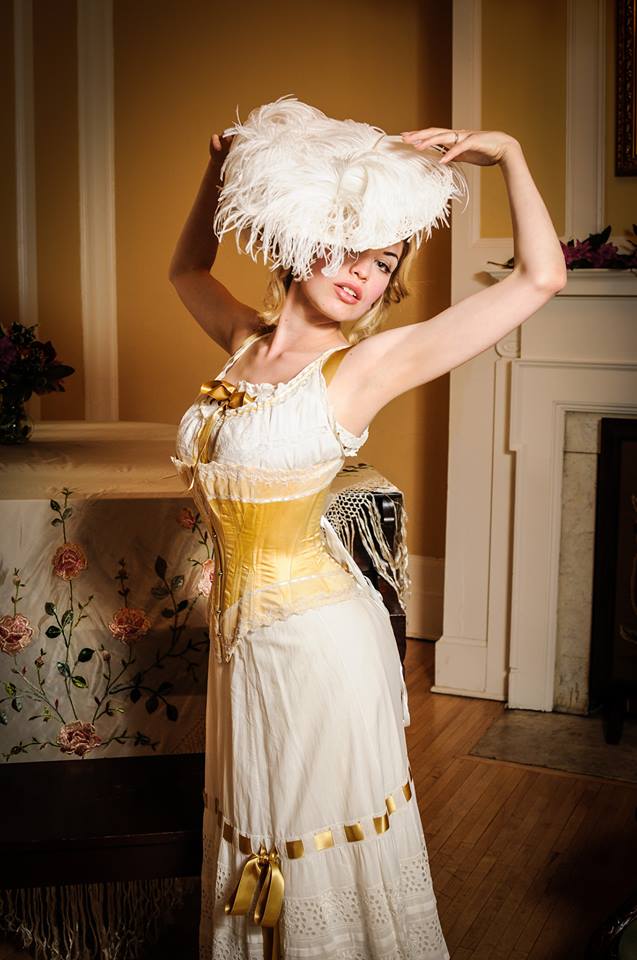Duchess silk reinforced with steel and laced with satin. These are the makings of the corsets that crowd the Lace Embrace Atelier window. Inside is a world of secret, intricate luxury. A young woman in stays stands in the light, admiring her mirrored silhouette from her perch on a wooden platform, which doubles as a dressing room when the peach brocade curtains are drawn. A petite blonde counsels her, plucking at ribbons and making small adjustments.
The blonde is Melanie Talkington, a Vancouver-based corsetière and doyenne of the lost art of body-structuring undergarments. She’s utterly engrossed in her task. To Talkington, a corsetière is more than a tailor; she’s a sculptor of human flesh, moulding the waistline, enhancing curvature and lifting posture. Her tools are gussets, flossing and bones.
Talkington’s love affair with outmoded lingerie began well before burlesque became trendy, mainstream theatre. It was 1982 when eight-year-old Talkington glimpsed a corset onscreen at the drive-in—she was supposed to be slumbering in the back seat of the family car. “I noticed that the women didn’t look typical, and I asked my mother how they got their shape. My interest was piqued,” she says.
After scouring her great-grandmother’s house for lacy treasures without success, it wasn’t until Talkington was in her early 20s that she acquired her first antique corset. She corresponded with a collector, who sent snapshots and later the ultimate prize: a rare scarlet wool corset from 1860. Since then, Talkington hasn’t stopped collecting.
Although Talkington went on to study fashion design at Kwantlen College, corset making wasn’t in the curriculum. She acquired her rare skills by gently flipping through the tissue-paper pages of a stash of turn-of-the-century French lingerie trade journals. As her collection of curving bodices—which range from richly hued, festooned satin to humble, herringbone coutil—multiplied, so too did her skill. Talkington learned by handling antiquities with her fingers and tracing patterns directly from undergarments worn in the Victorian and Edwardian eras.
“At the time I started my collection, people who collected antique corsets were wearing them, and they were destroying them. They’re too fragile to try on,” says Talkington. Her resolve to preserve the history of the craft is stiffer than a corset busk.
Talkington’s private cache of corsets now consists of over 130 specimens, indicating a passion that defies necessity. “My collection is the largest private collection in North America and possibly the world. The Symington Collection in England comes close with 124 corsets. I’ve even outbid the Met,” she says, arching her eyebrows.
Yet who exactly wears a corset these days? Melanie Talkington does, although when she isn’t, her waist retains the delicate, nipped-in appeal and impeccable posture of one who is laced. Dita Von Teese is another habitué—first a client, requesting a custom French reproduction in raspberry silk, and since, more. “Dita’s a friend,” says Talkington. “When I’m in L.A. or Paris, we meet. It’s fun to go lingerie shopping with her.” The actors in the action film Sucker Punch, released in spring 2011, are another group who have donned her handiwork. Still, a steady stream of women who are neither subculture starlets nor Hollywood glamazons come and go from the East Van boutique as Talkington explains the corset’s appeal.
The fascination with corsetry today, she says, is not about taking back feminine imagery. Talkington swiftly dismisses any attempt at a feminist interpretation. For women who are generously endowed, the overbust corset is a smart architectural solution, taking pressure off the shoulders in such a way that a bustier or bra cannot. To women who fear losing their waistlines with age, a bespoke underbust corset is a hero, providing gradual reshaping.
“I measure my clients carefully, and I show them how to lace the corset comfortably,” Talkington explains. “Of course it’s restrictive: you have to bend at legs. But you can do all sorts of things in a corset. I’ve set up trade shows; I’ve hauled boxes.” She pauses, before adding, “Corsets are empowering. Even though I can do everything in a corset, I still find that I get more help from men when I’m wearing one.”









